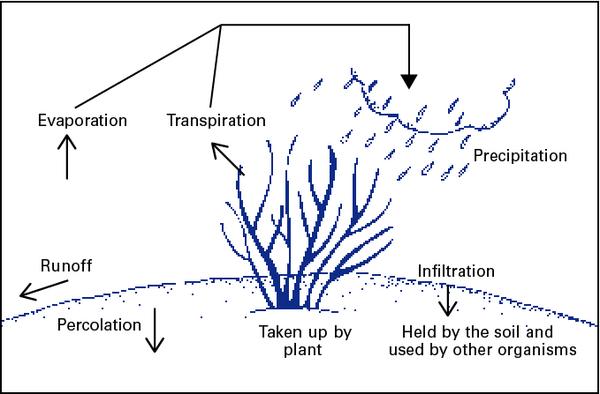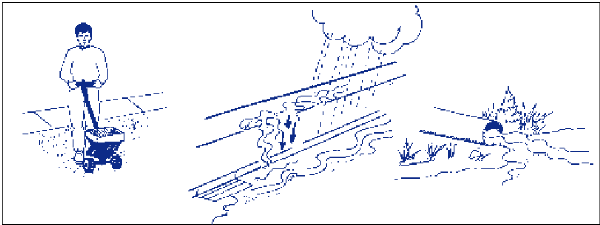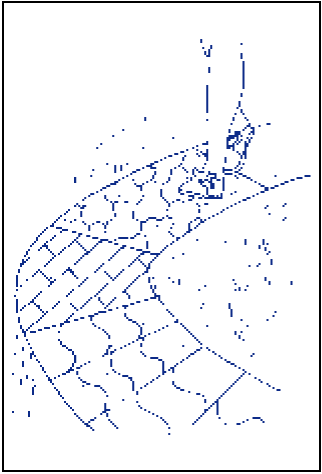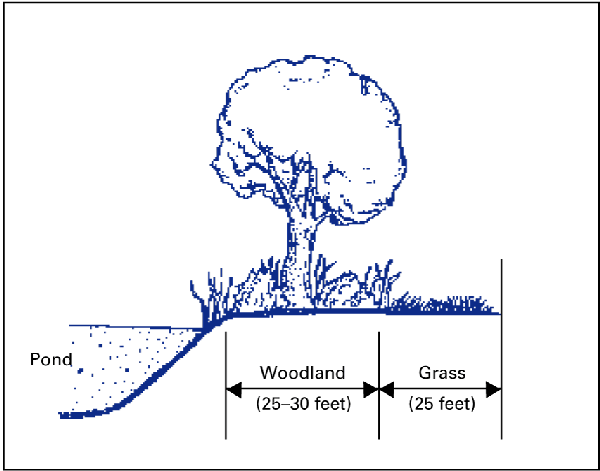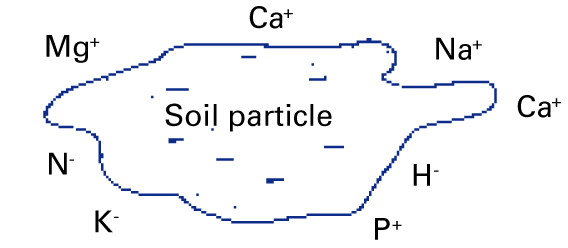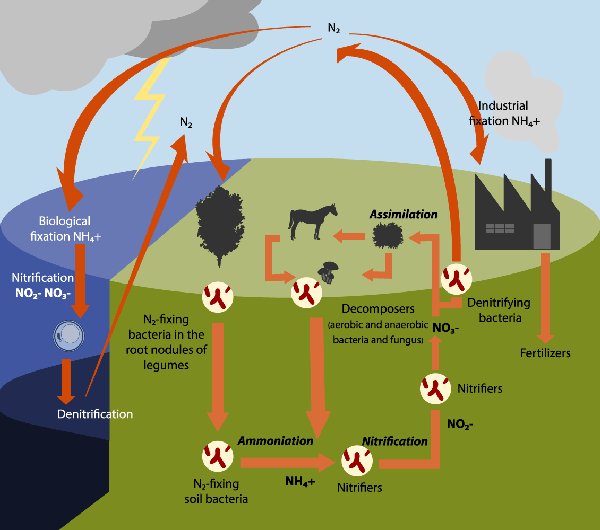Each year we gardeners plant and fertilize vegetable and flower gardens, trees, shrubs, and lawns. We see the rewards of our efforts in the enhanced beauty of our landscapes and the fresh fruits and vegetables on our dinner table. But in the process of growing plants, we change the environment by moving and adding nutrients and organic matter to the soil. Some of these changes can have an unintended effect—pollution of our water supply.
No one knows the exact impact gardening practices may have on water quality. One gardener living miles from a stream or lake might not make a significant impact; but, on the other hand, the cumulative contribution from thousands of home gardeners could significantly affect water quality.
The need to look at how gardening practices affect water quality has become critical as the population and the amount of paved surfaces have increased. Loss of wetlands and forested areas has decreased the land’s ability to discharge runoff slowly and to purify the water supply naturally. Our rivers have the capacity to restore themselves, but only if we reduce the stress placed on them by nutrient and sediment pollution.
A basic understanding of soil, water, and fertilizer can help us grow plants better and, at the same time, reduce potentially harmful effects on water quality. The goal is to reduce the amount of soil and fertilizer that moves from its original location and ends up in rivers, lakes, and streams.
Water Cycle
Most of the earth’s water is in constant motion (Figure 1). The movement of water in a river and the falling of water as precipitation can be seen easily. The less visible stages of movement include water evaporation from the surface of a lake or from the soil, transpiration (water loss from plant foliage), infiltration (water movement into soil), percolation (water movement through the soil), and groundwater movement. Water that moves downward through the soil ends up in the groundwater. Groundwater then can move into surface water bodies, such as ponds and streams.
Average rainfall for most of North Carolina is 49 inches a year. Water evaporation from the soil, from surface water, and from plant transpiration (collectively called “evapotranspiration”) accounts for approximately 35 inches. This leaves about 14 inches of water that either runs off or drains through the soil. Water that runs off the soil surface, as well as water that leaches through the soil, will at some point become part of a lake or river that will be used for drinking water.
Water Runoff
What you do in your yard impacts water quality because any rainwater that flows through your landscape as surface runoff carries with it yard and pet waste as well as excess fertilizer and pesticides (Figure 2). Even water that that percolates through your soil can transport chemicals that can contaminate ground water. These pollutants end up in our streams, rivers, estuaries, and coastal waters where they can disrupt the natural balance of plant and animal life.
An oversupply of nitrogen and/or phosphorus can stimulate the growth of algae. These tiny plants block the sunlight needed by underwater grasses, which provide protection and food for fish and other aquatic animals. Excessive alga growth also can reduce the aesthetic appearance of our rivers and limit their recreational value. When algae die, their decomposition consumes vast amounts of oxygen. Depleted oxygen levels can cause fish kills. Low oxygen levels may also result in extra cost to treat contaminated water before it can be reused for human consumption or may even make it unusable for drinking water.
Reducing Runoff
Potential damage from pollutants can be reduced if the speed and amount of runoff are slowed and the water is allowed to soak into the soil. By slowing the speed of runoff, soil erosion also is reduced.
Hard surfaces do not allow water to soak into the ground. To reduce the problem, keep the amount of hard surfaces to a minimum. When installing a new sidewalk or patio, consider using gravel, porous concrete, mulch, crushed stone, stepping stones, interlocking pavers, wood decks, or bricks on a sand base (Figure 3). These materials allow more rainwater to soak into the ground.
Direct the runoff from the house roof onto grassy areas or mulched planting beds instead of onto hard or paved surfaces. Most of this water will soak into the soil. If the plants in the planting bed are not tolerant of wet conditions, direct the water onto the lawn. Plants such as azaleas and rhododendrons require good drainage and may be killed by excessive moisture.
Use splash blocks or mulch to soften the impact if the water from the roof falls on bare ground. Consider using a rain barrel to collect water from the downspouts if your house has gutters. A lid will keep out pests such as mosquitoes. A cistern is a very large rain barrel that collects water from the roof and has a spout for easy use in watering plants.
The lawn is an excellent place to channel runoff. Research has determined that a dense, healthy lawn has 15 times less runoff than does a thin lawn. Grass roots form a mat that holds the soil and filters surface water, trapping sediments and chemicals before they have a chance to cause water pollution. Nutrient runoff from grassy areas is quite low.
Examine the slope and contour of your landscape. Swales (small dips in the ground) and berms (raised earthen areas) can be used to divert or slow the runoff. Grassed waterways may need to be constructed if large volumes of water need to drain. Grassy buffers and water diversions also can be used to trap soil and phosphorus.
Make extra efforts on property adjoining a stream, lake, or pond. Consider leaving (or creating) a buffer strip (Figure 4). A 25- to 30-foot strip of woodland (nearest the water edge) and a 25-foot section of grass will slow runoff, filter water pollutants, and provide food and shelter for wildlife.
Increasing Water Absorption
Soil compaction reduces the space between soil particles. This slows water and air movement in soils and reduces water-holding capacity. Traffic over the soil, especially when the ground is wet, will compact soil particles in the top few inches into a hard layer. Walking on, playing on, even mowing the lawn when the soil is wet slowly contribute to soil compaction. Major compaction occurs from construction traffic when a house is built. You can reduce soil compaction by keeping cars off the lawn and using landscaping to direct foot traffic along walkways. Compaction is frequently a problem with clayey soil. It is less of a problem with sandy soils.
You can increase soil pore space by tilling and incorporating organic matter; both will improve the ability of your soil to absorb and retain water. Coring a lawn will also help reduce soil compaction. Also called aerating, this is the removal of small cores of soil from the top inches of soil to allow nutrients, water, and air to enter the root zone. Root growth around the hole increases and plant vigor is enhanced. Some lawn care and landscape companies offer a coring service and rental equipment is also available. Use equipment that removes soil cores rather than punching holes in the soil as spiking will not reduce compaction.
Other Benefits of Coring
- Enhanced water uptake.
- Improved fertilizer uptake.
- Reduced runoff.
- Enhanced gas exchange.
- Better thatch breakdown.
- Enhanced heat and drought tolerance.
Coring should be done when the lawn is actively growing so that it will recover from injury. It is best to core cool-season grasses in fall or early spring. Warm-season grasses are best cored in late spring or early summer. Frequency of coring depends on the extent of soil compaction. Heavy, clayey soils may need coring every year.
Soil Erosion
Soil is a valuable resource and the foundation of plant growth. But it can cause harm in the wrong places. Water flowing from the landscape after a heavy rain or heavy irrigation can carry sediment and nutrients that pollute our waterways. Wind can blow loose soil and deposit it in rivers and streams. When soil sediment is washed into waterways, it clouds the water (reduces sunlight) and puts stress on aquatic life. Sediment also accumulates in stream beds and river bottoms, destroying habitat, reducing the water depth, and limiting recreational value. Eroding soil can carry nutrients, especially phosphorus, and excessive levels of phosphorus in fresh water can lead to an overabundance of algae.
Signs of Soil Erosion
- Exposed tree roots, small stones, rocks.
- Soil splashed on windows and outside walls.
- Small gullies beginning to develop.
- Widening or deepening of stream channels.
- Sediment collecting in low areas or on pavement.
How Erosion Occurs
Water droplets from rain or irrigation loosen the soil and splash soil particles short distances. The particles then are easily carried along the soil surface into waterways. When rain falls faster than the soil can absorb it, water runs off the land and carries soil particles with it. Runoff from roofs and hard surfaces causes the water flow to gain speed. With enough speed, the surface runoff can carry soil particles as it flows. Slopes are more prone to erosion because water moves quickly as it flows downhill. Erosion usually increases with the steepness and length of the slope.
Tilling can harm water quality as recently cultivated soils are easily eroded. Tilling just before a hard rain is the most damaging. Ideally, you should leave a grass border between a tilled area and a water drainage or hard-surface area. It is especially important to leave a grassy border in the direction the water drains. Tilling decreases soil particle size and increases the amount of air in the soil. Soils that are tilled frequently are often low in organic matter. Overtilling soils into a fine powder increases erosion.
It may be difficult or impossible to grow grass on some areas of the yard, thus increasing the likelihood of erosion. In areas that are too shady, too rocky, or too steep, either improve the conditions for growing grass or plant a more suitable ground cover. Most ground covers are less demanding than turf. Ground covers help hold soil in place, and their foliage will reduce the impact of rain droplets as they hit the soil.
Internal Soil Drainage
Internal drainage of soil water is influenced by soil slope, texture, structure, and the physical properties of surface and subsoil layers. Gravity will pull some of the soil water downward. This water moves through the soil profile to the water table. As soil water moves below the root zone, it can carry chemicals such as nitrogen. This downward movement of water below the root zone is referred to as leaching. Excessive rainfall or irrigation increases the downward movement of water. Excessive or improper use of nitrogen (both natural and manufactured) increases the chances of groundwater contamination.
The amount of water retained after gravitational water has drained is called the soil's water-holding capacity. Water retention is affected by the amount of organic matter, pore size, and texture of a soil. Sandy soils drain quickly (Figure 6). They hold only about 1⁄4inch of water per foot of soil depth. Clayey soils hold more of what they absorb, about 21⁄2to 3 inches of water per foot of soil. Adding organic matter will improve the water-holding capacity of sandy soils and will open up the pore spaces of clayey soils, allowing them to drain more quickly.
Ways to Reduce Soil Erosion
- Stabilize slopes with grasses, shrubs, or ground covers.
- According to recommendations based on soil test results, adequately fertilize and lime to promote vigorous plant growth.
- Align rows in a vegetable garden to follow the contour of the land instead of running rows up and down the slope.
- Do not over till.
- Use mulch under trees and shrubs to reduce the impact of falling water.
- Plant a winter cover crop to protect bare soil in vegetable gardens and annual flowerbeds.
- Plant a grass strip or place mulch between vegetable rows.
- Create a water diversion, such as a grass waterway.
- Apply straw mulch after seeding a new lawn.
- Leave a buffer of native vegetation around the property.
- Use silt fences during major construction projects.
- Maintain a thick, healthy lawn.
Fertilizer
Careless or unnecessary use of lawn and garden fertilizers can contribute to nitrogen and phosphorus pollution of streams, rivers, lakes, estuaries, and coastal waters. Nutrient management consists of pollution-prevention practices that manage the rate, time, and method of fertilizer application. This reduces the likelihood of phosphorus transfer from runoff or of nitrogen leaching into groundwater.
Synthetic (manufactured) and natural (organic and inorganic) fertilizers provide nutrients for plant growth. The nutrients that are mostly likely to limit plant growth if not present at adequate levels are nitrogen, phosphorus, and potassium.
Soil Nutrients
Nutrients can be present in the soil as undissolved minerals chemically bound to soil particles (like phosphorus) or dissolved in soil water (like nitrogen). Some nutrients have a negative charge while others have a positive charge (Figure 7). The soil particles themselves have a negative charge and thus attract and hold nutrients with a positive charge, such as magnesium, calcium, sodium, and phosphorus. Nutrients with a negative charge, such as nitrate nitrogen, potassium, and hydrogen, are not attracted to or held by the negatively charged soil particles and are more subject to leaching into groundwater.
Nitrogen (N) is usually more responsible for increasing plant growth than any other nutrient. Few soils have enough natural nitrogen to promote rapid plant growth. Also, nitrogen does not normally accumulate in the soil, regardless of how much nitrogen fertilizer is applied. Thus, the total amount of nitrogen in cultivated soil remains relatively constant for years.
Nitrogen is a mobile nutrient; much like water, it is in constant motion.
Nitrogen applied to the soil can be used by plants, washed off the soil surface, leached through the soil, or lost to the air as a gas.
Some nitrogen from fertilizer moves into the atmosphere through a process called denitrification. The air we breathe is 78 percent nitrogen. Nitrogen from granular fertilizer can enter streams from surface runoff. Nitrogen loss is higher when a heavy rain immediately follows a surface application of fertilizer, especially on sloped areas. Incorporating fertilizer into the soil or lightly watering (% to 1 inch) after making a surface application will reduce the nitrogen loss from surface runoff and from denitrification.
Nitrogen losses also can occur with soil erosion. Improper placement or excessive application of compost, manure, or sewage sludge can cause water pollution. Heavy rains can wash these materials or their leachate into surface water.
Phosphorus (P) promotes early root formation and growth, as well as the production of flowers, fruits, and seeds. Many urban soils are low in phosphorus. When applied as fertilizer, phosphorus is quickly bound by soil particles. Phosphorus is relatively immobile in soils (except sand).
Since phosphorus does not leach through the soil water, how can it be part of the water quality problem?
One answer is that fertilizer applied to a hard surface can easily be washed away. Phosphorus is held tightly by fine soil particles such as clay and silt and by organic matter. Soil particles can be eroded by either wind or surface-water runoff and thus carry phosphorus into water sources. Phosphorus is also a component of plant material such as grass clippings, compost, manure, and leaves, which can be blown or washed into water.
Potassium (K) helps plants overcome drought stress, increases disease resistance, and improves winter hardiness. It can be leached through the soil by water, but not as quickly as nitrogen. Potassium in water has not been shown to cause detrimental health or environmental effects.
How Much Fertilizer to Use
You should determine how much fertilizer to use and when to apply it by looking at your soil-test results, rainfall, soil type, plant age, and the amount of plant growth observed or desired. Simply applying fertilizer because a plant is not growing adequately will not solve most plant problems (insects, disease, poor drainage, soil compaction). The proper amount of fertilizer to apply is the amount recommended by a soil test. Have the soil tested before planting and every two to three years thereafter.
Types of Fertilizer
Generally, the timing and rate of fertilizer application are more critical than the type you purchase. In regard to water quality, the most important issue is the type of nitrogen in the fertilizer. Most fertilizers contain nitrogen in a quick-release form, others come in a slow-release form, and some are a combination of both.
Quick-release> forms of nitrogen are immediately available to plants, but their effects do not last long. They can cause plant damage if a large application is made. Table 1 provides information on nitrogen content, leaching potential, and response time of several fertilizer> materials.
Only 50 percent of the applied nitrogen are used by plants; the rest is lost to the atmosphere, to runoff, or through leaching. Much of the concern over nitrogen loss centers on the movement of unused nitrate> nitrogen into groundwater, which eventually can be discharged into surface water. Using slow-release nitrogen fertilizers can reduce the potential problem.
Ammonium nitrate, ammonium >sulfate, calcium nitrate, and potassium nitrate (Table 1) are all water-soluble, quick-release forms of nitrogen. The nitrogen becomes available as soon as it comes in contact with soil water. Urea is an organic form of nitrogen, but it also is converted to nitrate nitrogen quickly. High application rates combined with high irrigation or rainfall can result in large amounts of nitrogen being leached below the root zone. Do not apply fertilizer before a heavy rain.
A slow-release fertilizer releases nutrients at a rate that makes them available to plants over a long period. The initials WIN and WSN on fertilizer labels stand for “water-insoluble nitrogen” and “water-soluble nitrogen,” respectively. Water-soluble nitrogen dissolves readily and is usually in a simple form, such as ammonia nitrogen or nitrate nitrogen. Water-insoluble nitrogen is referred to as slow-release nitrogen. Nitrogen that will not dissolve readily is usually in an organic form, with the exception of urea. >Natural forms of nitrogen and coated, commercial, controlled-release fertilizers must be broken down into simpler forms by soil microorganisms before they can be used. Most organic materials used as fertilizers release nutrients slowly.
| Fertilizer source | Percent N | Leaching potential | Burn potential | Low temperature response | Residual effect |
|---|---|---|---|---|---|
| Activated sewage sludge | 6 | Very low | Very low | Very low | Long |
| Ammonium sulfate | 21 | High | High | Rapid | Short |
| Ammonium nitrate | 33 to 34 | High | High | Rapid | Short |
| Calcium nitrate | 16 | High | High | Rapid | Short |
| IBDU | 0 to 31 | Moderate to low | Low | Moderate | Moderate |
| Potassium nitrate | 13 | High | High | Moderate | Short |
| Resin-coated urea | 24 to 35 | Low | Low | Moderate | Long |
| Sulfur-coated urea | 14 to 38 | Low | Low | Moderate | Moderate |
| Urea formaldehyde | 38 | Low | Low | Low | Moderately long to long |
| Urea | 45 to 46 | Moderate | High | Rapid | Short |
| Urea solutions | 12 to 14 | Moderate | High | Rapid | Short |
Time of Application
The best time and method of applying fertilizer vary with the type and age of the plant. Remember that nitrogen has its greatest effect for three to four weeks after application. Late fall or early spring is the best time to fertilize. At planting, nitrogen requirements are relatively low. Most established woody plants perform well with just one application per year, but if you are trying to push the growth of a young hedge, make several light applications of fertilizer per year. As woody plants mature, the need for nitrogen decreases. Rapid growth is no longer needed or desired. Plant roots normally grow twice as far as the branches, and trees and shrubs near lawns pick up part of the fertilizer applied to the lawn. This may be sufficient fertilizer for established plants.
How to Reduce the Impact of Fertilizers on Water Quality
Before applying fertilizer
- Soil-test to determine phosphorus and potassium fertilizer needs.
- Calibrate fertilizer spreaders.
- Test the nutrient content of manures and other organic materials.
- Maintain a grass border around the vegetable garden.
What kind of fertilizer
- Use a slow-release fertilizer.
- Use iron as a supplement to green-up lawns.
When to fertilize
- Just before the plants enter a period of rapid growth, apply two-thirds of the nitrogen.
- Make split, light applications of nitrogen on sandy soils.
How much fertilizer
- Apply no more than 1 pound of nitrogen per 1,000 square feet per application.
How to apply fertilizer
- Use a drop spreader instead of a rotary spreader, especially near driveways or sidewalks.
Where to apply fertilizer
- Avoid applying fertilizer to hard surfaces, such as sidewalks, driveways, and patios.
- Avoid getting fertilizer into natural drainage areas or ditches.
After fertilizing
- Incorporate fertilizer into the soil where possible.
- Apply 1⁄4 to 1⁄2 inch of water after making a fertilizer application.
- Fill and wash spreaders over grassy areas instead of over hard surfaces.
- Sweep up and reuse fertilizer that falls on hard surfaces.
- Refrain from using fertilizer to melt ice on sidewalks or steps.
- Prevent irrigation runoff.
Yard Waste
Fertilizer and soil are not the only substances that can add nutrient pollution to rivers, lakes, and streams. Grass clippings, leaves, compost, manure, and other yard waste can move into street gutters and ditches with stormwater. Water from storm drains is not treated by municipal or other water treatment facilities and empties directly into streams and rivers. Research has shown that preventing grass clippings and leaves from entering the water supply through street gutters and ditches can reduce the level of phosphorus in lakes. When mowing,do not direct clippings into a ditch or street. Also, remove grass clippings and leaves from hard surfaces as soon as possible.
Do not dump yard waste in or near lakes and streams. As organic debris like leaves, dead grass, and weeds decompose, soluble forms of nitrogen and phosphorus are released. The microorganisms that decompose these materials consume and possibly deplete oxygen in the water.
A lawn of 1,000 square feet can produceup to 500 pounds of clippings in one growing season. Many homeowners bag lawn clippings because they think the clippings add to the buildup of thatch. This is not true. Clippings that remain on the lawn decompose quickly and release valuable nutrients. You can reduce fertilizer needs by 20 to 30 percent if you leave the clippings on the lawn. The shorter the clippings, the deeper they fall into the turf. A mulching mower and/or frequent mowings produce the smallest clippings.
Create a compost pile and recycle yard waste. Compost can be used as a soil conditioner toimprove soil structure, texture, aeration, and the ability to absorb rain or irrigation water. Planting beds can be used as a place to recycle fallen leaves, small branches from pruning, and grass clippings. The back corner of a natural area is a good place to dispose of dead weeds, Christmas trees, and spent flowers.
Other Causes of Water Pollution
Other potential causes of water pollution include pesticide, gasoline, and motor oil spills. Fill lawn mowers with gasoline carefully. Conduct such activities over lawn areas instead of on hard surfaces. Stay away from wells, ditches, waterways, sewer inlets, and street gutters. Take paints, solvents, cleaners, and pesticides to a county household hazardous waste center.
Use plants that are adapted to the specific site chosen and are more pest tolerant to reduce the use of pesticides and fertilizers. It is important to select plants that will grow in the conditions present (shade, sun, drainage conditions).
Pet wastes that enter waterways add nutrients and can be a source of bacteria that pose human health hazards. Dispose of pet waste by flushing the material down the toilet, burying it in the yard, or placing it in the trash. Do not use pet waste as a fertilizer in the vegetable garden. Also, do not add pet waste to a compost pile. Temperatures in the compost pile do not reach levels that will kill all harmful organisms. Animal and pet pens should be located so runoff water can be filtered by a grass border before it enters a ditch or street gutter.
Additional Information
Compost and Mulch:
Composting Chapter of the North Carolina Extension Gardener Handbook
Backyard Composing of Yard, Garden and Food Discards, AG-791
Lawns:
Lawns Chapter of the North Carolina Extension Gardener Handbook
Improving Lawn Care and Gardening, AG-439-82
Organic Lawn Care: A Guide to Organic Lawn Maintenance and Pest Management, AG-562
Organic Gardening:
Organic Gardening Chapter of the North Carolina Extension Gardener Handbook
Organic Lawn Care: A Guide to Organic Lawn Maintenance and Pest Management, AG-562
Soils and Fertilizer:
Soils and Plant Nutrients Chapter of the North Carolina Extension Gardener Handbook
A Gardener’s Guide to Fertilizing Trees and Shrubs, AG-613
A Gardener’s Guide to Soil Testing, AG-614
Acknowledgement
This publication is a revision of an earlier version. The authors would like to thank Erv Evans for his earlier contributions.
For additional information, contact Luke Gatiboni, Extension Specialist, Department of Soil Science.
Publication date: Jan. 1, 2000
Reviewed/Revised: Aug. 8, 2019
AG-612
N.C. Cooperative Extension prohibits discrimination and harassment regardless of age, color, disability, family and marital status, gender identity, national origin, political beliefs, race, religion, sex (including pregnancy), sexual orientation and veteran status.

